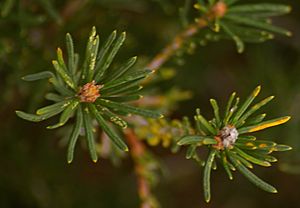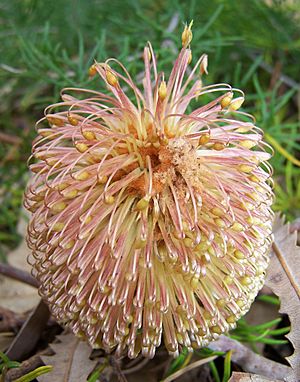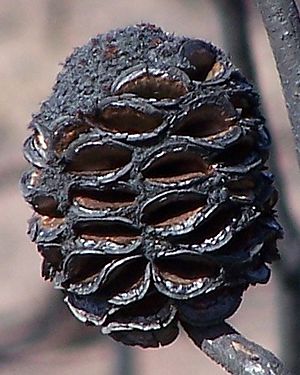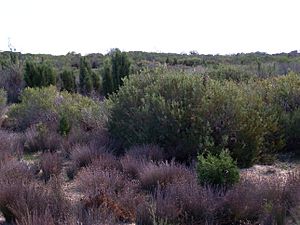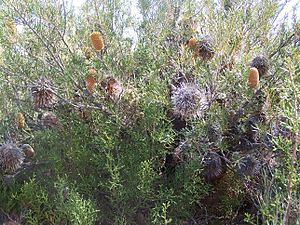Swamp fox banksia facts for kids
Quick facts for kids Swamp fox banksia |
|
|---|---|
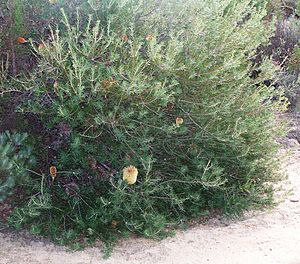 |
|
| Scientific classification | |
| Kingdom: | |
| (unranked): | |
| (unranked): | |
| Order: | |
| Family: | |
| Genus: | |
| Species: |
B. telmatiaea
|
| Binomial name | |
| Banksia telmatiaea A.S.George
|
|
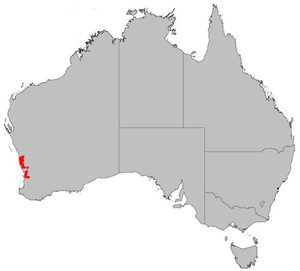 |
|
| Distribution of Banksia telmatiaea | |
The swamp fox banksia (Banksia telmatiaea) is a special kind of bush. It loves to grow in wet places like marshes and swamps. You can find it along the lower west coast of Australia. This plant can grow up to 2 meters (about 7 feet) tall.
It has thin leaves and flower spikes that are pale brown. These flower spikes make a lot of sweet liquid called nectar. Scientists first collected this plant in the 1840s. But it wasn't officially named a separate species until 1981. Before that, people thought it was just another type of fox banksia.
This bush usually grows in scrubland areas. These are low-lying places that get wet during certain times of the year. You can find it between Badgingarra and Serpentine in Western Australia. Not much is known about how it lives or how to protect it. But we do know that birds and small mammals help pollinate its flowers. People don't often grow the swamp fox banksia in gardens.
Contents
What Does the Swamp Fox Banksia Look Like?
The Banksia telmatiaea is an upright bush. It can reach a height of up to 2 meters (7 feet). Its stems and branches are covered in tiny hairs. The leaves are straight and narrow. They are about 1.5 to 3 centimeters (0.5 to 1 inch) long.
The top of the leaves is green. The underside is white and hairy. When new leaves grow, they are pale brown. Later, they turn green.
Flower Spikes and Nectar
The flowers grow in "flower spikes." These are like big, dense clusters of hundreds of tiny flowers. They grow from older branches, usually those more than four years old. A flower spike is shaped like an oval or cylinder. It is about 3 to 5 centimeters (1 to 2 inches) tall. It can be 4 to 7 centimeters (1.5 to 2.75 inches) wide.
Each spike has between 500 and 900 golden-brown flowers. Each flower has a tube-like part and a long, thin style. The style is hooked at the end. It starts hidden inside the flower. But it breaks free when the flower opens. This plant usually flowers from April to August. Sometimes, it flowers as late as November.
The flowers take about five to six weeks to grow from a bud. Then they open fully over two weeks. These flowers make a lot of nectar. So much, in fact, that it can drip to the ground!
How Does the Fruit Grow?
After flowering, a strong, woody "cone" forms. It looks hairy because old flower parts stay on it. This cone can hold up to 70 woody seed pods, called follicles. Each follicle holds one seed.
Like other Banksia plants, only a few flowers turn into follicles. For the swamp fox banksia, only about 4% of flowers on a cone will make seeds. Many cones don't make any seeds at all. Scientists are not sure why so few seeds are produced.
How Was the Swamp Fox Banksia Named?
Discovery and Naming
The swamp fox banksia was first collected around 1840. Two people, Ludwig Preiss and James Drummond, found it. For many years, people thought it was the same as B. sphaerocarpa. But by 1980, scientists realized it was a different species.
Alex George officially named it in 1981. He collected a sample in 1969. He noticed it looked a lot like B. leptophylla. But it grew in swamps, not sandy soil. It also flowered in winter. These differences made him decide it was a new species.
George named it telmatiaea from a Greek word. "Telmat-" means "the mud of a pond." This name refers to its swampy home. So, its full scientific name is Banksia telmatiaea A.S.George. People also call it "marsh banksia."
How is it Grouped with Other Plants?
Scientists group plants to show how they are related. Alex George placed B. telmatiaea in a group called Abietinae. This group includes banksias with roundish flower spikes. He thought its closest relative was B. leptophylla. That plant has longer leaves and bigger flowers.
Later, other scientists used cladistics (a way to study relationships) to group banksias. Their studies showed B. telmatiaea was closely related to B. scabrella, B. leptophylla, and B. lanata. This grouping is based on how the plants look and their DNA.
The current scientific grouping of Banksia telmatiaea is:
Where Does the Swamp Fox Banksia Live?
The swamp fox banksia only grows in certain areas of Western Australia. These are the Swan Coastal Plain, Geraldton Sandplains, and Jarrah Forest regions. It grows inland from the coast. But it never grows east of the Darling Scarp.
You can find it from Hill River in the north to Serpentine in the south. Most of these plants are found north of Moore River or south of Cannington. There are only a few groups in between.
Its Favorite Home
This plant likes low-lying areas that get wet in certain seasons. But they should never be completely underwater. It often grows at the edges of swamps and marshes. For example, in the Yule Brook Botany Reserve, it grows on slopes and higher parts of clay flats. It avoids the lowest, flooded areas and the dry, high ridges.
It prefers deep grey sandy soils. Or it likes shallower sand over a hard clay layer. Other plants that grow nearby are usually scrubland or shrubland bushes. Sometimes, water-loving trees like B. littoralis or Melaleuca preissiana are also present. They can even form a low, open woodland.
Ecology: How the Swamp Fox Banksia Lives
Special Roots and Fire Survival
Like most other Proteaceae plants, the swamp fox banksia has special roots. They are called proteoid roots. These roots have dense clusters of short side roots. They form a mat just under the leaf litter. These roots are very good at getting nutrients from poor soils. This is important because Australian soils often lack nutrients like phosphorus.
The swamp fox banksia does not have a lignotuber. A lignotuber is a woody swelling at the base of some plants. It helps them regrow after a fire. So, adult swamp fox banksia plants are killed by bushfires. But it has a clever way to survive. It releases its seeds after a fire. This is called serotiny. The seeds are stored in the plant's woody cones. After a fire, the cones open. This helps new plants grow quickly.
The seeds are not released right after the fire. The seed pods open, but the seeds are held in place by a winged separator. When it rains, these wings close up. As they dry, they open again. This pushes the seeds out. This means seeds are only released after the first rains following a fire. This helps them grow better.
Pollination and Visitors
Several birds visit the flowers of the swamp fox banksia. These include the red wattlebird, silvereye, New Holland honeyeater, and brown honeyeater. The European honeybee is also often seen. Ants and plasterer bees have also been recorded visiting.
Small mammals probably help pollinate too. Their droppings have been found on the flower spikes. Also, the plant has features that attract night-time mammals. Its flowers have a strong, musky smell. They grow low down, hidden in the leaves. They make lots of nectar, especially at dawn and dusk. This timing helps attract birds in the morning and mammals in the evening. It is less appealing to insects, which are active during the day.
Pests and Seed Loss
Insects can harm the flower spikes and seed pods. The swamp fox banksia's flowers are not as badly affected as some other Banksia species. One study found less than 10% of its flower spikes were infested. Other Banksia species had over 50% or even 90% infestation.
The Arotrophora arcuatalis moth is the main pest for the flowers. Its larvae burrow into the woody center of the spike. This stops the spike from producing seeds. However, the seed pods themselves are heavily infested. Over 90% of cones with seeds had larvae from a moth called Xylorycta. These larvae eat the seeds, causing 100% seed loss in affected cones.
Mysterious Nectar
The swamp fox banksia has very unusual flower nectar. Most Banksia species have clear, watery nectar. But this plant's nectar is pale yellow at first. Then it gets darker and thicker. Within a day or two, it turns into a thick, olive-green goo. Eventually, it becomes an "almost black, gelatinous lump."
Scientists first noticed this in 1980. They thought tiny organisms called cyanobacteria were causing the change. They wondered if these bacteria helped the plant by adding nitrogen to the soil. But later studies found no evidence of nitrogen fixing. In 1996, scientists thought the color change was a chemical reaction from the plant itself. As of 2007, the exact cause was still unknown. The nectar has normal sugars, but mostly sucrose.
Protecting the Swamp Fox Banksia
The swamp fox banksia is a fairly safe species. Most groups have more than 100 plants. Also, 26% of known plants are in protected areas. However, it grows close to Perth. This means that clearing land for new buildings could be a threat. In 1988, a report suggested that the species should be watched. This is because land clearing could greatly change its situation.
This plant is also sensitive to a disease called dieback. This disease is caused by a water mold called Phytophthora cinnamomi. It causes root rot. The swamp fox banksia is so easily affected that it is used to show if the disease is present.
Scientists have also looked at how climate change might affect this plant. Very severe climate change could lead to its extinction. But with less severe changes, its range might actually grow. This depends on if it can move into new suitable areas.
In 1987, it was listed as "rare" but not endangered. Western Australia's Department of Parks and Wildlife does not consider it rare now. So, it is not on their list of rare or priority plants.
Growing the Swamp Fox Banksia
People don't often grow the swamp fox banksia in gardens. It grows quite fast. But it can become a bit messy as it gets older. Its flower spikes are pretty. But they are often hidden inside the bush by the leaves.
In its natural home, it flowers a lot for several months. But it might not flower as much when grown in a garden. You can trim it lightly, but don't cut below the green leaves. Experts suggest planting it in a sunny spot. It likes soil that doesn't drain well, especially with moisture in winter. The seeds don't need any special treatment. They usually sprout in about 14 days.


